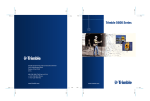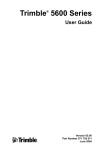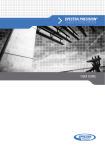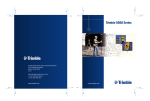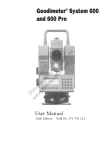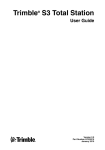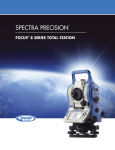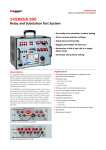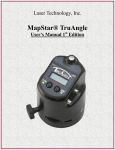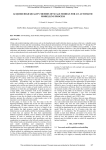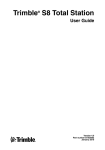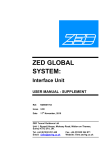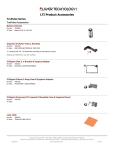Download Spectra Precision FOCUS 10 Total Station User Guide - Nikon
Transcript
Spectra Precision FOCUS 10 ® ® User Guide Version 02.00 Part Number 571 257 201 August 2007 Contact details Spectra Precision 10355 Westmoor Drive Suite #100 Westminister, CO 80021 U.S.A. +1-720-587-4700 Phone 888-477-7516 (Toll Free in U.S.A.) www.spectraprecision.com Copyrigt and Trademarks Copyright © 2005-2007, Spectra Precision. All rights reserved. Autolock, FOCUS, Spectra Precision and Tracklight are trademarks of Spectra Precision, registered in the United States Patent and Trademark Office and other countries. Spectra Precision logo is a Trademark of Spectra Precision. All other trademarks are the property of their respective owners. Release Notice This is the August 2007 release version 02.00 of the Spectra Precision FOCUS 10 User Guide, part number 571 257 201. It applies to the Spectra Precision FOCUS 10 total station. The following limited warranties give you specific legal rights. You may have others, which vary from state/jurisdiction to state/jurisdiction. Registration To receive information regarding updates and new products, please contact your local dealer or visit the Spectra Precision website at www.spectraprecision.com/register. Upon registration you may select the newsletter, upgrade or new product information you desire. Notices Australia and New Zealand This product conforms with the regulatory requirements of the Australian Communications Authority (ACA) EMC framework, thus satisfying the requirements for C-Tick Marking and sale within Australia and New Zealand. Canada This Class B digital apparatus complies with Canadian ICES-003 This digital apparatus does not exceed the Class B limits for radio noise emissions from digital apparatus as set out in the radio interference regulations of the Canadian Department of Communications. Le présent appareil numérique n’émet pas de bruits radioélectriques dépassant les limites applicables aux appareils numériques de Classe B prescrites dans le règlement sur le brouillage radioélectrique édicté par le Ministère des Communications du Canada. N 10233 This device has been designed to operate with an antenna having a maximum gain of 2.0 dBi. Antenna having a higher gain is strictly prohibited per regulations of Industry Canada. The required antenna impedance is 50 ohms. To reduce potential radio interference to other users, the antenna type and its gain should be so chosen that the equivalent isotropically radiated power (EIRP) is not more than that required for successful communication. Operation is subject to the following two conditions: (1) this device may not cause interference, and (2) this device must accept any interference, including interference that may cause undesired operation of the device. Europe This product has been tested and found to comply with the requirements for a Class B device pursuant to European Council Directive 89/336/EEC on EMC, thereby satisfying the requirements for CE Marking and sale within the European Economic Area (EEA). These requirements are designed to provide reasonable protection against harmful interference when the equipment is operated in a residential or commercial environment.The alert sign indicates the device is classified as a Class 2 device, implying that certain restrictions apply to its use, according to the following: Devices marked with Part Numbers 58050008, 58060008, 58070008 and 58080008 may be used all over the European Community, excluding France. Devices marked with Part Numbers 58052008, 58062008, 58072008 and 58082008 is exclusively for use in France. The compliance to the applicable requirements is detailed in the official Declaration of Conformity document, which is filed at Spectra Precision. For product recycling instructions and more information, please go to www.spectraprecision.com/ev.shtml. Recycling in Europe: To recycle Spectra Precision WEEE (Waste Electrical and Electronic Equipment, products that run on electrical power.), Call +31 497 53 24 30, and ask for the "WEEE Associate". Or, mail a request for recycling instructions to: Spectra Precision Europe BV c/o Menlo Worldwide Logistics Meerheide 45 5521 DZ Eersel, NL USA Class B Statement – Notice to Users. This equipment has been tested and found to comply with the limits for a Class B digital device, pursuant to Part 15 of the FCC rules. These limits are designed to provide reasonable protection against harmful interference in a residential installation. This equipment generates, uses, and can radiate radio frequency energy and, if not installed and used in accordance with the instructions, may cause harmful interference to radio communication. However, there is no guarantee that interference will not occur in a particular installation. If this equipment does cause harmful interference to radio or television reception, which can be determined by turning the equipment off and on, the user is encouraged to try to correct the interference by one or more of the following measures: – Reorient or relocate the receiving antenna. – Increase the separation between the equipment and the receiver. – Connect the equipment into an outlet on a circuit different from that to which the receiver is connected. – Consult the dealer or an experienced radio/TV technician for help. Changes and modifications not expressly approved by the manufacturer or registrant of this equipment can void your authority to operate this equipment under Federal Communications Commission rules The antenna used for this transmitter must be installed to provide a separation distance of at least 20 cm from all persons and must not be colocated or operating in conjunction with any other antenna or transmitter: FCC ID: HSW- 2410M. Taiwan Battery Recycling Requirements The product contains a removable Lithium-ion battery. Taiwanese regulations require that waste batteries are recycled. Important Information Before using the Spectra Precision® FOCUS® 10, make sure that you understand this User Guide, as well as all equipment and jobsite safety requirements. Laser Safety This equipment has been tested and found to comply with IEC 60825-1 January 2001, 21 CFR 1040.10 and 1040.11 except for deviations persuant to Laser Notice no. 50, dated May 27, 2001. C Use of controls or adjustments or performance of procedures other than those specified herein may result in hazardous LED or Laser radiation exposure. As with any bright light source, such as the sun, electric welding arcs or arc lamps, common sense applies. DO NOT look into the laser aperture when the laser is on. For further information regarding safe use of lasers, refer to the IEC standard 60825-1 January 2001. I Queries Address any questions you may have about laser safety to: Spectra Precision 5475 Kellenburger Road Dayton, OH U.S.A. 45424-1099 Attention: Laser Safety Officer, Quality Assurance Group Phone +1-937-233-8921 ext 824 or 800 538-7800(Toll free in the USA) Fax +1-937-233-9661 Spectra Precision FOCUS 10 The FOCUS 10 contains one light source: A laser diode for the distance measuring function operating at 850 nm (infrared, non-visible light), with a beam divergence of 0.4 x 0.8 mrad and an output power of < 0.48 mW, laser CLASS 1. II Environmental Information NOTICE FOR SPECTRA PRECISION’S EUROPEAN UNION CUSTOMERS Spectra Precision is pleased to announce a new recycling program for our European Union customers. At Spectra Precision, we recognize the importance of minimizing the environmental impacts of our products. We endeavor to meet your needs, not only when you purchase and use our products, but also when you are ready to dispose of them. That is why Spectra Precision is actively pursuing, and will continue to pursue, the expanded use of environmentally friendly materials in all its products, and why we have established a convenient and environmentally friendly recycling program. As Spectra Precision makes additional recycling facilities available for your use, we will post their locations and contact information to our Recycling Instructions web page. For product recycling instructions and more information, please go to www.spectraprecision.com/environment/summary.html Recycling in Europe: To recycle Spectra Precision WEEE, Call +31 497 53 2430, and ask for the “WEEE Associate” Or Mail a request for recycling instructions to: Spectra Precision c/o Menlo Worldwide Logistics Meerheide 45 5521 DZ Eersel, NL I II Declaration of Conformity EC-Declaration of Conformity to the Essential Requirements of the applicable Directives, 89/336/EC and 73/23/EEC including amendments by the CE marking Directive, 93/68/EEC Product: Instrument – Spectra Precision Focus 10 Types/Models Focus 10 X Focus CU Manufacturer: Part Numbers 571257003, 572257003 571257810, 572257810 Notes X = Code for accuracy Trimble AB Box 64, Rinkebyvägen 17 SE-182 11 Danderyd Sweden This declaration is based on the full compliance of the products with the following European harmonized standards: EMC: EN 61000-6-2:2001 EN 61000-4-2 (1995) + A1 (1998) + A2 (2001) EN 61000-4-3:2002/A1/A2 EN 61000-6-3:2001 EN 55022/A1/A2 Class B Laser Safety: EN 60825-1:1994 + A1 (2002) + A2 (2001) As manufacturer, we declare under our sole responsibility that the equipment follows the provisions of the Directives stated above. Danderyd 2007-06-21 Original signed ......................................................... Martin Holmgren Engineering Manager Trimble AB IV Box 64, Rinkebyvägen 17 Telephone No: +46 8 622 1000 Telefax: +46 8 753 2464 SE-182 11 Danderyd, Sweden www.trimble.com Org.No: 556550-9782 VAT.No: SE556550978201 Table of Contents 1 Welcome Welcome to Spectra Precision FOCUS 10 .................... 1-2 Glossary of terms used with the System (Only with FOCUS 10 CU) .................................................................. 1-2 2 Introduction Unpacking & Inspection ................................................. 2-3 Inspection...................................................................... 2-3 Controls ......................................................................... 2-4 Pre-Measurement .......................................................... 2-6 Connecting the external battery to the instrument ........ 2-6 The Side Cover.............................................................. 2-7 The Central Unit............................................................. 2-8 Laser and LED Information............................................ 2-9 Spectra Precision FOCUS 10........................................ 2-9 3 Surveying methods Overview........................................................................ 3-2 Conventional surveying with servo ................................ 3-2 Conventional surveying with Autolock ........................... 3-3 Aiming .......................................................................... 3-3 How to Check Aiming .................................................. 3-4 Robotic Surveying.......................................................... 3-5 Equipment ..................................................................... 3-5 4 Angle Measurement System Overview........................................................................ 4-3 The Angle Measuring Technique ................................... 4-3 Table of Contents Dual Axis Compensator................................................ 4-3 Correction for Collimation Errors................................. 4-4 Correction for Trunnion Axis Tilt................................. 4-4 Single-Face Angle Measurement.................................. 4-5 Two-Face Angle Measurement...................................... 4-5 5 Distance Measurement System Overview........................................................................ 5-3 Distance Measurement.................................................. 5-3 Automatic control of signal level.................................. 5-4 Measurement range and accuracy ................................. 5-4 6 Servo Overview........................................................................ 6-2 Servo controls................................................................ 6-2 Motion knobs ................................................................ 6-2 7 Tracklight Overview........................................................................ 7-3 8 Tracker Overview........................................................................ 8-2 9 Radio Overview........................................................................ 9-2 Radio controls................................................................ 9-2 Select radio channel ...................................................... 9-2 Station address .............................................................. 9-2 Radio license................................................................. 9-3 Range ............................................................................ 9-3 Table of Contents 10 Power Supply Batteries....................................................................... 10-2 Internal Battery unit (Central unit) ............................. 10-2 External Battery/Radio Battery................................... 10-2 Single Adapter ............................................................ 10-3 Multi Adapter.............................................................. 10-4 Battery Cables............................................................. 10-5 Battery Charging.......................................................... 10-6 Single Charger (572 906 330)..................................... 10-6 Super Charger (572 906 145) (Optional) .................... 10-7 Power Unit (572 906 146)........................................... 10-8 About charging NiMH (and NiCd) batteries............... 10-8 Bat Low....................................................................... 10-9 11 RMT Remote Targets Overview...................................................................... 11-2 RMT 602 ...................................................................... 11-3 RMT 606 ...................................................................... 11-4 12 Care & Maintenance Overview...................................................................... 12-2 Cleaning ...................................................................... 12-3 Condensation............................................................... 12-3 Packing for Transport.................................................. 12-3 Table of Contents CHAPTER 1 1 Welcome Welcome to Spectra Precision FOCUS 10........................... 1-2 Glossary of terms used with the System (Only with FOCUS 10 CU)....................................................................................... 1-2 1 Welcome Welcome to Spectra Precision FOCUS 10 Wellcome to the Spectra Precision FOCUS 10 User Guide. This manual describes the different functions of the FOCUS 10 total station and how to best use it in order to get most out of your equipment. Even if you have used other surveying equipment before, it is reccomended that spend some time reading this guide to learn about the special features of this product. Glossary of terms used with the System (Only with FOCUS 10 CU) Area File: A file in the memory device that holds known coordinates (Pno, N, E etc.) or Roadline data. A/M-key: Aim/Measure button. Initiates a measurement and controls search and remote measurements. D: Accurate measurement with mean value calc. dH & dV: These values represents the collimation errors. When performing D-bar measurements in two faces these errors do not affect the accuracy of the measurement (HA, VA). If the values differs a lot from 0 it is recommended that you perform a test measurement (MNU5). Free Station: Also known as Resection. Location of the total station by measuring distance and/or angles to 2 or up to 8 points. 1-2 Spectra Precision FOCUS 10 User Guide Glossary of terms used with the System (Only with FOCUS 10 CU) FSTD: Fast Standard measurement, with A/M. IH: Instrument height over the point. Job File: A file in a the memory device that holds data collected in the field. This file can consist of any data. Logon: Entering Job file and memory unit when designing a U.D.S with program 40. Offset: Length offset to measured slope distance. Prism const: The prism’s length offset from the 0-constant. Ref. Obj: Reference Object, also back sight. REG-key: The register key. This stores data in the data collector. R.O.E: Remote Object Elevation. SH: Signal height. STD: Standard measurement, with A/M. TRK: Tracking measurement, automatic and continuous measurement. U.D.S.: User Defined Sequence. A program designed by the user determining what is Spectra Precision FOCUS 10 User Guide 1-3 1 Welcome collected, its order of collection and how it is displayed on the screen.vm SH dELE IH ELE 1-4 Spectra Precision FOCUS 10 User Guide Point to set out CHAPTER 2 2 Introduction Unpacking & Inspection ....................................................... 2-3 Inspection........................................................................ 2-3 Controls................................................................................ 2-4 Pre-Measurement ................................................................ 2-6 Connecting the external battery to the instrument .......... 2-6 The Side Cover .................................................................... 2-7 The Central Unit ................................................................... 2-8 Laser and LED Information .................................................. 2-9 Spectra Precision FOCUS 10 ......................................... 2-9 2 Introduction Figure 2.1 FOCUS 10 Series 2-2 Spectra Precision FOCUS 10 User Guide Unpacking & Inspection Unpacking & Inspection Before we begin to describe the operating procedure of your Spectra Precision FOCUS 10, it is first necessary to acquaint yourself with the equipment received: • • • • • • • Instrument Unit Transport case Tribrach Rain cover Reflective sight marks (stick-on) User Manual (CD only) Tool kit Note – Some equipment is market dependent Inspection Inspect the shipping container. If it is received in poor condition, examine the equipment for visible damage. If damage is found, immediately notify the carrier and your sales representative. Keep the container and packing material for the carrier’s inspection. Spectra Precision FOCUS 10 User Guide 2-3 2 Introduction Controls Here you find a list of the controls of your instrument. Please take at moment to familiarize yourself with the names and the locations of the controls. Coarse sight Central unit Internal battery or Tracklight and/or Tracker Vertical motion servo control Horizontal motion servo control Figure 2.2 FOCUS 10 instrument shown from the operator side (back). 2-4 Spectra Precision FOCUS 10 User Guide Controls Prism symbol (which marks the instrument height (IH), also on the opposite side cover) Figure 2.3 FOCUS 10 instrument seen from the side. Spectra Precision FOCUS 10 User Guide 2-5 2 Introduction Pre-Measurement Connecting the external battery to the instrument The instrument can be equipped with an external battery that is connected to the instrument via the battery cable. The cable is to be connected to the connector on the instrument resp. battery as shown in the picture below. Figure 2.4 Connecting the external battery to the instrument. 2-6 Spectra Precision FOCUS 10 User Guide The Side Cover The Side Cover The instrument can be configured with two different side covers; a plain or a radio unit cover. It is possible to change side cover if you need another type, but it has to be done at a Spectra Precision authorized service center. Plain Cover Radio Unit Cover The radio unit cover is needed when you wish to use the instrument for remote surveying or robotic surveying (one-person total station), Equipment Spectra Precision FOCUS 10 User Guide 2-7 2 Introduction The Central Unit The central unit can be configured with the internal battery, the Tracklight® or the tracker unit. You can change between battery unit and Tracklight by yourself, but the tracker unit must be installed at a Spectra Precision authorized service center. Internal battery The internal battery gives you 2 hours of continuous use. Tracklight Tracklight is a visible guide light which is an aid to the rodman e.g. when setting out. Tracker The tracker has control of the instruments when using the system for robotic surveying (one-person system) or in Autolock® mode. 2-8 Spectra Precision FOCUS 10 User Guide Laser and LED Information Laser and LED Information Spectra Precision FOCUS 10 The FOCUS 10 has been tested and complies with the regulations for a Class 1 Laser product. See laser safety information on the first pages of this manual. Distance Measuring Laser aperture Figure 2.5 Laser aperture Spectra Precision FOCUS 10 User Guide 2-9 2 Introduction 2-10 Spectra Precision FOCUS 10 User Guide CHAPTER 3 3 Surveying methods Overview .............................................................................. 3-2 Conventional surveying with servo....................................... 3-2 Conventional surveying with Autolock.................................. 3-3 Aiming ............................................................................. 3-3 How to Check Aiming...................................................... 3-4 Robotic Surveying ................................................................ 3-5 Equipment....................................................................... 3-5 3 Surveying methods Overview This chapter will describe the different ways of working with the FOCUS 10. Since the instrument is equipped with servo drive, you’ll find that the system is very easy to handle, when setting out you can with a touch of a single key aim the instrument towards the set out point. Conventional surveying with servo Your instrument is equipped with servo drive, this means a lot of advantages: • In e.g. setting out you only need to give the point number. The instrument will calculate and aim automatically towards the precalculated bearing with a single press of the positioning key . • For angle measurements, just aim towards the different reflector stations once. The instrument remembers and repeats the aiming process how ever many times and in what ever order you want. Fine adjustments might be needed. • During aiming, the servo assists the horizontal and vertical adjustments. All that’s needed is a light circular movement of the adjustment screw with your finger tip. • Thanks to servo-drive, adjustments screws have no end positions. That means no unnecessary interruptions, when aiming. 3-2 Spectra Precision FOCUS 10 User Guide Conventional surveying with Autolock Conventional surveying with Autolock With the feature Autolock, you do no longer have to fine adjust or focus, since this is taken care of by the system. • To upgrade a base unit to Autolock, you’ll only need to add a Tracker unit and an RMT target. It is also possible to measure in a conventional way without Autolock using an ordinary reflector. • When setting out, you’ll only need to supply a prestored point and the system will calculate the necessary data for setting out. Then, position the instrument with the positioning key. When the rodman, guided by the builtin Tracklight enters the Tracker’s field of view (2.5m/100m), the instrument locks onto the RMT automatically. You’re now able to fully concentrate on the information in the display (radial/right angle offset) and direct the rodman to the setting out point. Aiming The adjustment between the two optical axes, the telescope and the tracker, may differ. The difference will make it seem like the instrument does not point towards the center of the prism, when using Autolock, figure 3.1. This is not a problem since the two axis have their own separate collimation data. It is however important to make collimation test for both axes. Spectra Precision FOCUS 10 User Guide 3-3 3 Surveying methods Manual aiming Figure 3.1 Autolock aiming Difference between aiming manually and Autolock (The error has been exaggerated in the figure) How to Check Aiming You can check how well the instrument is calibrated by measuring toward the prism with and without Autolock and compare the measured angles: 1. Aim manually at a prism and read out the horizontal and vertical angles. 2. Turn on Autolock and let the instrument lock on to the same prism automatically, read out the horizontal and vertical angles. 3. Compare the angles between manual and Autolock aiming. If the difference between the read out angles is significant, you should carry out both a horizontal and vertical angle 3-4 Spectra Precision FOCUS 10 User Guide Robotic Surveying collimation adjustment, and a tracker collimation adjustment. Robotic Surveying By equipping the instrument with a tracker unit, even aiming can be done from the measuring point. The entire measurement is performed from the point, with the same access to all functions of the total station as if you were standing beside it. Robotic surveying means higher production capacity. During setting-out, it’s best with two people: one to handle the measuring with the robotic rod, and one to mark the points. Of course, the entire job can be performed by a single person. The unique search function makes robotic surveying extremely efficient 24 hours a day. Equipment To be able to work with robotic surveying you’ll need a data collector, instrument with a radio side cover and tracker unit, an RMT (Remote Target) and an external radio connected to the collector. The data collector, external radio and RMT will hereafter be called, Robotic rod. Spectra Precision FOCUS 10 User Guide 3-5 3 Surveying methods 3-6 Spectra Precision FOCUS 10 User Guide CHAPTER 4 4 Angle Measurement System Overview .............................................................................. 4-3 The Angle Measuring Technique.......................................... 4-3 Dual Axis Compensator .................................................. 4-3 Correction for Collimation Errors..................................... 4-4 Correction for Trunnion Axis Tilt...................................... 4-4 Single-Face Angle Measurement.................................... 4-5 Single-Face Angle Measurement......................................... 4-5 Two-Face Angle Measurement ............................................ 4-5 4 Angle Measurement System Automatic correction for deviation in relation to the plumb axis Automatic correction for collimation error Automatic correction for trunnion axis tilt Figure 4.1 The Angle Measurement System 4-2 Spectra Precision FOCUS 10 User Guide Overview Overview The FOCUS 10 meets all demands for efficient and accurate angle measurement. It also allows you to choose the measuring method with which you feel most comfortable. The angle measurement system gives you full compensation for the following: • Automatic correction for angle sensor errors. • Automatic correction for collimation error and trunnion Axis tilt. • Automatic correction for tracker collimation error. • Arithmetic averaging for elimination of pointing errors. The Angle Measuring Technique One of the strong features of the design of the FOCUS 10 is its electronic angle measurement system, which eliminates the angle errors that normally occur in conventional theodolites. The principle of measurement is based on reading an integrated signal over the whole surface of the angle sensor and producing a mean angular value. In this way, inaccuracies due to eccentricity and graduation are eliminated. Dual Axis Compensator The instrument is also equipped with a dual axis compensator which will automatically correct both horizontal and vertical angles for any deviations in the plumb line. The system warnes immediately of any deviations in excess of ±10c (6’). Spectra Precision FOCUS 10 User Guide 4-3 4 Angle Measurement System Correction for Collimation Errors By carrying out a simple pre-measurement test procedure both horizontal and vertical collimation of the instrument can be quickly measured and stored. All angles measured thereafter are automatically corrected. These collimation correction factors remain in the internal memory until they are measured again. Correction for Trunnion Axis Tilt During the same pre-measurement test procedure, it is also possible to measure and store angular imperfections of the horizontal tilt axis relative to the horizontal axis. This stored correction factor is applied automatically to all measured horizontal angles. When should these tests be carried out? 1. After transport where hard handling may have occurred. 2. When the temperature differs by > 10 ºC from the previous application. 3. Immediately prior to high precision angle measurement. How are these tests carried out? See “Test Measurements”, chapter 4 in FOCUS 10 CU User Guide General Part 1. 4-4 Spectra Precision FOCUS 10 User Guide Two-Face Angle Measurement Single-Face Angle Measurement The above described features admits efficient and accurate angle measurement in a single face, since the instruments errors are automatically corrected with constants which were stored during the test measurement. During Single Face angular measurements, with the compensator engaged and pre-measurement and storage of collimation and tilt axis errors have been executed, each displayed angle will be compensated for the following: • Horizontal and vertical circle graduation and eccentricity errors. • Plumb line deviation errors. • Horizontal and vertical collimation errors. • Tilt axis errors. It is worth mentioning that human error sources such as telescope sighting (these errors can be almost nullified by measuring in two faces) and imperfections in the optical plummet of the tribrach still remain. Two-Face Angle Measurement The instrument can be used in exactly the same manner as a conventional theodolite, i.e. in both the left and right face. These two-face situations will hereafter be referred to as Circle 1 and Circle 2 positions. Two face measurements can be used for legal reasons, or when additional concern of accuracy and documentation is demanded. When measuring in STD-mode you measure and store each angle value of the two faces and get a display value of the total collimation and sighting error. Spectra Precision FOCUS 10 User Guide 4-5 4 Angle Measurement System When measuring in D-bar mode you can decrease the sighting error by repeating measurements and mean value calculation of each sighting. The number of repeated sightings can be chosen depending on the current measuring conditions. The final mean value calculated angles are displayed and stored in this mode. Angle values for each face are also available. 4-6 Spectra Precision FOCUS 10 User Guide CHAPTER 5 5 Distance Measurement System Overview .............................................................................. 5-3 Distance Measurement ........................................................ 5-3 Automatic control of signal level ..................................... 5-4 Measurement range and accuracy ................................. 5-4 5 Distance Measurement System 5-2 Spectra Precision FOCUS 10 User Guide Overview Overview The distance module of FOCUS 10 operates within the infrared area of the electromagnetic spectrum. It transmits an infrared light beam. The reflected light beam is received by the instrument and, with the help of a comparator, the phase delay between transmitted an received signal is measured. The time measurement of the phase delay is converted and displayed as a distance with mm accuracy. Note – When taking measurements with servo instruments and having the Tracker installed there may be a distance error if you use large prisms. Distance Measurement The internal function of the distance measurement module can be varied depending on the nature of the particular survey application in question. There are four methods of distance measurement STD Standard measurements towards stationary targets (standard mode) STD Fast measurements towards stationary targets (fast standard mode) D TRK Precision measurements towards stationary targets (arithmetical mean value D-bar mode) Measurements towards moving targets (tracking mode) e.g setting out or hydrographic surveying. Also functions as automatic measuring mode for polar measurement and tacheometry. Spectra Precision FOCUS 10 User Guide 5-3 5 Distance Measurement System The choice of measurement method is often based on the experience of the operator and of course the practical precision demanded by the current survey task. Automatic control of signal level The FOCUS 10 total station has an automatic signal control which adjusts the measurement signal level to an optimal value of each distance measured. Measurement range and accuracy Since the Spectra Precision instruments are constantly improved we refer to the Technical Specifications sheets for the up-to-date measurement range and accuracy figures of the respective models. 5-4 Spectra Precision FOCUS 10 User Guide CHAPTER 6 6 Servo Overview .............................................................................. 6-2 Servo controls ...................................................................... 6-2 Motion knobs................................................................... 6-2 6 Servo Overview The FOCUS 10 is equipped with servo controlled motors for positioning of the unit. The servo is in use when performing a number of different operations; when turning the motion knobs, when positioning with the servo control keys, for automatic test and calibration or when using the tracker for robotic surveying.. Servo controls Motion knobs The servo is manually controlled by the two motion knobs located at the side of the instrument. The motion knobs are sensitive in four steps so that the more you turn the knob the faster the servo will rotate the instrument. If you want to switch to fine mode adjustment when operating a motion knob, turn the opposite direction and fine adjust. Vertical motion knob Horizontal motion knob 6-2 Spectra Precision FOCUS 10 User Guide CHAPTER 7 7 Tracklight Overview .............................................................................. 7-3 7 Tracklight Figure 7.1 Tracklight® emits a red, white and green sector of flashing light where the white light coincides with the measuring beam. 7-2 Spectra Precision FOCUS 10 User Guide Overview Overview Tracklight is a visible guide light which enables the rodman to set himself on the correct bearing. It consists of a flashing three coloured light, each colour lying within its own lateral projection sector. If the rodman is to the left of the measuring beam, he will observe a green flashing light; if to the right, a red flashing light; if on-line with the measuring beam of the instrument, a white flashing light. The frequency of the flash will increase by 100% as soon as the light beam strikes the reflector, which will confirm for the staff – man that he/she is holding the rod in the correct position. Once the rodman is on-line, the distance will immediately appear on the display. Tracklight also provides the operator with an excellent facility for clearing sight lines and for working during the hours of darkness. The instrument measuring beam width at 100 m is 15 cm. The width of the Tracklight beam at the same distance is 10 m. The Tracklight unit slides onto the underside of the measuring unit or if the instrument is equipped with a tracker the Tracklight is a part of the tracker unit. The Tracklight is activated from the data collector. Spectra Precision FOCUS 10 User Guide 7-3 7 Tracklight 7-4 Spectra Precision FOCUS 10 User Guide CHAPTER 8 8 Tracker Overview .............................................................................. 8-2 8 Tracker Overview FOCUS 10 can be equipped with a Tracker unit which is needed when using the system for robotic surveying or when performing conventional surveying with Autolock. The tracker has control over the instrument’s servos and aims the instrument correctly towards the target, which in these cases must be an RMT (Remote Target). An automatic search function is optional. 8-2 Spectra Precision FOCUS 10 User Guide CHAPTER 9 9 Radio Overview .............................................................................. 9-2 Radio controls ................................................................. 9-2 Select radio channel ....................................................... 9-2 Station address ............................................................... 9-2 Radio license .................................................................. 9-3 Range ............................................................................. 9-3 9 Radio Overview To be able to communicate between the instrument and the robotic rod the instrument must be equipped with a radio side cover and the data collector must be connected to an external radio. The radio side cover consists of a built in radio and an antenna. Radio controls Select radio channel The radio channel is selected from the Control Unit. Up to 12 channels can be used depending on how many are supplied or permitted by authorities in each country. Select a channel when the CU is attached to the instrument. Then when the CU is detached and connected to the external radio, this radio will automatically get the same channel as the instrument. The range of different channels makes it possible to work with more then one FOCUS 10 at a working site. It is though important that each system has its own radio channel so that not any disturbances will occur. Station address If disturbances occur on the radio channel from other systems in the same area, try to change channel. If that does not help the instrument and the robotic rod can be given an unique address. Choose menu 1.5, Radio with the data collector attached to the instrument. Here you are prompted to enter a station address and a remote address between 0 and 99. 9-2 Spectra Precision FOCUS 10 User Guide Radio controls Radio license Note that the radio frequencies used are not harmonized within EC and only permitted in one particular country or area. Make sure that your radio is intended for the country, where it is to be used. The information of destination country can be found on the External radio or on its package. Before using the system at your working site it is important to know that in some countries it is necessary to have a user license. Make sure that your local agent has informed you about the regulations in your country. Range The actual range in which the radio can work is depending on the conditions. Range can be decreased if other radios are in operation in your area or when you are working in an area with many reflecting objects. Spectra Precision FOCUS 10 User Guide 9-3 9 Radio 9-4 Spectra Precision FOCUS 10 User Guide CHAPTER 10 Power Supply 10 Batteries ............................................................................. 10-2 Internal Battery unit (Central unit) ................................. 10-2 External Battery/Radio Battery...................................... 10-2 Single Adapter .............................................................. 10-3 Multi Adapter................................................................. 10-4 Battery Cables .............................................................. 10-5 Battery Charging ................................................................ 10-6 Power Unit (572 906 146) ............................................. 10-8 About charging NiMH (and NiCd) batteries................... 10-8 Bat Low ......................................................................... 10-9 10 Power Supply Batteries Internal Battery unit (Central unit) The internal NiMH 12 V, 1.8 Ah battery unit (Part Nr. 572 257 460) slides into the underside of the measuring unit. This is the standard battery for the measuring unit. Figure 10.1 Battery unit 12V for central unit. External Battery/Radio Battery The external NiMH 12V, 3.5 Ah battery (Part No. 572 204 270), which is also common to other Spectra Precision products, is connected to the instrument via the Single Adapter (Part No. 572 204 256) or Multi Adapter (Part No. 572 204 273) described below and a standard Hirose cable. The battery also fits directly on the External Radio. 10-2 Spectra Precision FOCUS 10 User Guide Batteries Figure 10.2 External Battery/ Radio Battery, 12V, 3.5 Ah Single Adapter The Single Adapter (Part No. 572 204 256) is used when you want to connect the External NiMH Battery (Part No. 572 204 270) to a FOCUS 10 via a standard Hirose cable. The adapter slides onto the upper side of the External Battery. The adapter has two Hirose connectors and a bracket for attaching it to a tripod. Charger connector Single adapter External battery Spectra Precision FOCUS 10 User Guide 10-3 10 Power Supply Multi Adapter The Multi Adapter (Part No. 572 204 273) is used to connect up to three External NiMH Battery units (Part No. 572 204 270) to a FOCUS 10 via a standard Hirose cable. The adapter slides onto the upper sides of the External Batteries. The adapter has 2+2 Hirose connectors and a bracket for attaching it to a tripod. Three External Batteries will result in a total capacity of 10.5 Ah . Multi Adapter 3x External battery 10-4 Spectra Precision FOCUS 10 User Guide Batteries Battery Cables The multi functional cable is required if an external battery is used or when connecting the different Spectra Precision devices with each other. The different types of cables are listed below: Multi functional Cable 1m, 572 202 188, for connecting the FOCUS 10 or control unit to an external battery via the Single or Multi Adapter or to another control unit or instrument. Length: 1.0m. Multi functional Cable 2.5m, 572 202 216, same as the above cable. Length: 2.5m. Multi functional Cable 0,4m, 572 208 043, same as the above cable. Length: 0.4m. Multi functional spiral cable 0.75-1.75m, 572 208 068, same as the above cable. Length: 0.75-1.75m. Data Communication Adapter, 572 202 204, for connecting the FOCUS 10 or control unit to a computer and Power Supply or an external battery using the Single or Multi Adapter. Spectra Precision FOCUS 10 User Guide 10-5 10 Power Supply Battery Charging When charging the batteries to a FOCUS 10, it is important to use a charger dedicated to charging NiMh and NiCd batteries. The different types of chargers available are described in the following. Single Charger (572 906 330) A 230 or 115 VAC single battery charger. The charger has a single Hirose output that can handle one NiMH External Battery (572 204 270). Use together with Power Cable 571 905 925 (100-115V), 571 905 924(220V) or 571 908 040 (230V, UK plug) and Charger Cable 572 208 020 (for other batteries). 10-6 Spectra Precision FOCUS 10 User Guide Battery Charging Super Charger (572 906 145) (Optional) A microprocessor controlled charger for sequential charging of up to four Spectra Precision NiMH or NiCd batteries. It is run with 10-30 VDC and is fitted with a connector to suit both 19mm and 12mm cigarette lighter sockets. It shall only be used together with Power Unit (572 906 146). The ambient temperature while charging should be between +-0 ºC and +40 ºC. Use together with Charger Cable 572 208 020 (for other batteries). Warning – The Super Charger is for use together with Power Unit 572 906 146 only! Other power units or charging converters must never be used together with Super Charger. Spectra Precision FOCUS 10 User Guide 10-7 10 Power Supply Power Unit (572 906 146) A 90-260 VAC charging converter for use together with Super Charger (572 906 145). The Power Unit is equipped with a cigarette lighter socket and two Hirose connectors for FOCUS 10 system cabling. Use together with Power Cable 571 905 924 (230V), 571 905 925 (100-115V) or 571 908 040 (230V, UK plug). About charging NiMH (and NiCd) batteries The temperature while charging should be above +5 ºC but should not exceed room temperature. The condition of the battery will be better preserved if it is used until the FOCUS 10 indicates “Bat Low” and the automatic cut-out function is activated. Discharge of stored batteries can vary considerably, depending on the quality of the individual cells, especially at higher temperatures. It is therefore 10-8 Spectra Precision FOCUS 10 User Guide Battery Charging recommended to store them in room temperature or lower and recharge batteries if they have been stored for a longer period than two one month. Note – Please refer to the battery chargers instructions. Bat Low When battery capacity drops too low, “Bat Low” appears in the display window, and the instrument shuts off automatically. This gives you an opportunity to change the battery without losing instrument parameters and functions such as instrument height, signal height, coordinates, bearing, dual axis compensation, etc. Note that the battery change must be made within 2 hours; otherwise the above parameters and functions will be reset. Note – This safety backup of the instrument’s parameters and functions will work only when “Bat Low” appears on the display: It will not function if the battery is removed during operation. Spectra Precision FOCUS 10 User Guide 10-9 10 Power Supply 10-10 Spectra Precision FOCUS 10 User Guide CHAPTER 11 11 RMT Remote Targets Overview ....................................................................... 11-2 RMT 602 ....................................................................... 11-3 RMT 606 ....................................................................... 11-4 11 RMT Remote Targets Overview FOCUS 10 instruments equipped with an optional Tracker unit can perform surveying tasks using the Autolock function. If the instrument is upgraded with a radio, you will also be able to perform Robotic surveying, i.e oneperson surveying. To be able to use the above functions you must also use some type of Remote Measuring Target (RMT). A Spectra precision Remote Measuring Target consists of a prism reflector and one or several active tracker diodes. The great advantage of using active tracker diode(s) is that you eliminate the risk of the instrument locking on to other reflecting objects than the RMT. The RMT complies with the regulations for a Class 1 LED device. Note – The typical range of the RMT is depending on the weather conditions. 11-2 Spectra Precision FOCUS 10 User Guide RMT 602 RMT 602 RMT602 (Part No. 572 202 220) is the standard remote target for FOCUS 10. It can be used for distances up to 350 m and consists of a tracker diode unit with a miniature prism (Part No. 571 126 060) mounted in front (not included). The RMT602 remote target is powered by two standard 1.5V size LR6/AA replaceable batteries which fits into the unit. RMT602 can also be powered externally via the Hirose contact. Spectra Precision FOCUS 10 User Guide 11-3 11 RMT Remote Targets RMT 606 RMT606 (Part No. 572 204 610) is an optional 360° remote target for FOCUS 10. It can be used for distances up to 350 m. The RMT consists of a tracker diode unit with a set of active diodes forming a full 360 degree circle and a 360° prismring (Part No. 571 204 312)(not included). The RMT606 remote target is powered externally via the Hirose contact or directly from the power pole. 11-4 Spectra Precision FOCUS 10 User Guide CHAPTER 12 Care & Maintenance 12 Overview ............................................................................ 12-2 Cleaning ............................................................................. 12-3 Condensation ..................................................................... 12-3 Packing for Transport......................................................... 12-3 Service ............................................................................... 12-3 12 Care & Maintenance Overview The Spectra Precision total station is designed and tested to withstand field conditions, but like all other precision instruments, it requires care and maintenance. • Avoid rough jolts and careless treatment. • Keep lenses and reflectors clean. Always use lens paper or other material intended for cleaning optics. • Keep the instrument protected in an upright position, preferably in its transport case. • Don´t carry the instrument while mounted on the tripod in order to avoid damage to the tribach screws. • Do not rotate the instrument by the handle. This may have an affect on the HA ref. How much it effects the value depends on the quality of the tribach and the tripod. Use instead the servo controls to rotate the instrument. • Don´t carry the instrument by the telescope barrel. Use the handle. • When you need extremely good measurement precision, make sure the instrument has adapted to the surrounding temperature. Great variations of instrument temperature could affect the precision. Warning – The FOCUS 10 is designed to withstand normal electromagnetic disturbance from the environment. However, the instrument contains circuits sensitive to static electricity and the instrument cover must not be removed by unauthorized personnel. If the instrument cover has been opened by an unauthorized person, the function of the instrument is not guaranteed and the instrument warranty becomes invalid. 12-2 Spectra Precision FOCUS 10 User Guide Overview Cleaning Caution must be exercised when the instrument is cleaned, especially when sand and dust are to be removed from lenses and reflectors. Never use coarse or dirty cloth or hard paper. Anti-static lens paper, cotton wad or lens brush are recommended. Never use strong detergents such as benzine or thinner on instrument or case. Condensation After survey in moist weather the instrument should be taken indoors, the transport case opened and the instrument removed. It should then be left to dry naturally. It is recommended that condensation which forms on lenses should be allowed to evaporate naturally. Packing for Transport The instrument should always be transported in its transport case, which should be locked. For shipment to a service shop, the names of the sender and receiver should always be specified clearly on the transport case. When sending this instrument for repair, or for other service work, a note describing fault, symptoms or requested service should always be enclosed in the transport case. Service We recommend that you, once a year, leave the instrument to an authorized service workshop for service. This is to guarantee that the specified accuracies are maintained. Note that there are no user servicable parts inside the instrument. Spectra Precision FOCUS 10 User Guide 12-3 12 Care & Maintenance 12-4 Spectra Precision FOCUS 10 User Guide SPECTRA PRECISION® FOCUS™ 10 TOTAL STATION GETTING STARTED GUIDE Spectra Precision 7401 Church Ranch Blvd Westminster, CO 80021 USA +1-303-323-4100 Phone 888-477-7516 (Toll Free in USA) www.spectraprecision.com












































































